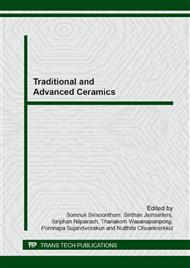p.97
p.103
p.108
p.114
p.122
p.127
p.132
p.141
p.147
Low-Temperature Synthesis of Cordierite Using Magnesite
Abstract:
Cordierite (2MgO·2Al2O3·5SiO2) has a low density of 2.2 g/cm3 due to its high magnesium content. Because of its low thermal expansion coefficient of 1~2 x10-6 /°C, many studies are being conducted on the synthesis of cordierite with the expensive petalite as a replacement for lithium alumina silicate-based heat-resistant materials. The cordierite can be synthesized over a wide range: SiO2 at 50~70%, Al2O3 at 20~40%, and MgO at 10~30%. In this study, the range of chemical composition and temperature of cordierite synthesis is thoroughly investigated. In particular, we use natural materials (magnesite, kaolin and clay) to examine how thermal properties are affected by changes in crystal phase arising from the varying composition of MgO, SiO2 and Al2O3. We focused on factors leading to an increase in the rate of cordierite synthesis at temperatures below 1280 °C. From observing the synthetic rate over 1250~1280 °C, the sintered body at 1280 °C had a high synthetic rate greater than 80%. Magnesite was ball milled at constant intervals, and mean particle size was controlled to improve the synthetic rate of cordierite. As a result, the cordierite synthetic rate increased by more than 15% with decreasing the mean particle size of magnesite.
Info:
Periodical:
Pages:
122-126
Citation:
Online since:
April 2014
Authors:
Keywords:
Price:
Сopyright:
© 2014 Trans Tech Publications Ltd. All Rights Reserved
Share:
Citation:


